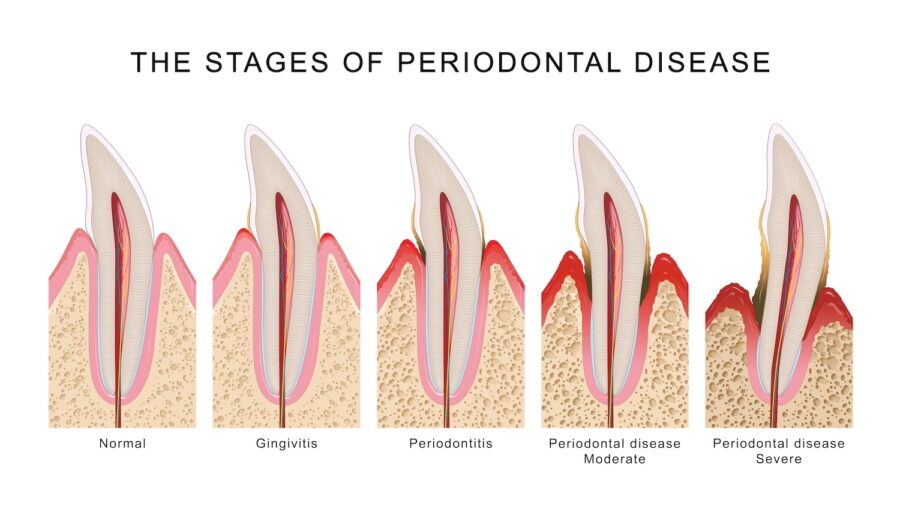
The Stages of Gum Disease: What You Need to Know
March 14, 2025 9:00 amBleeding gums when you brush? Bad breath that won’t go away? These may seem minor, but they can be early signs of gum disease. Gum disease is one of the most common oral health problems, yet many people don’t realize they have it until it’s advanced. At Ryan Dental in Olathe, KS, Dr. William Ryan and Dr. Randy Regier help patients catch gum disease early—before it leads to tooth loss or more serious issues.
What Are Periodontal Pockets?
Healthy gums fit snugly around your teeth, creating a seal that protects the bone beneath. When gum disease develops, bacteria irritate the gums, causing them to pull away from the teeth. This creates small gaps between the gums and teeth, known as periodontal pockets.
During your dental exam, your dentist or hygienist measures these pockets using a periodontal probe—this is when you hear numbers being called out during your visit. These numbers indicate pocket depth:
1-3mm – Healthy gum pockets, easy to clean with brushing and flossing.
4mm – A warning sign that gum disease is starting.
5mm or higher – A deeper pocket where bacteria thrive, making it impossible for a toothbrush or floss to reach.
As pockets deepen, bacteria continue to accumulate, leading to further bone loss and gum detachment. Without treatment, the infection progresses quickly, making teeth unstable.
Stage 1: Gingivitis (The First Warning Sign)
Gingivitis is the only stage of gum disease that can be reversed. At this point, plaque and bacteria cause red, swollen gums that may bleed when brushing or flossing. The good news? There’s no permanent damage yet. With proper brushing, flossing, and regular cleanings, your gums can return to a healthy state.
Signs of gingivitis:
Pink in the sink when brushing or flossing.
Bad breath that lingers.
Mild gum swelling or tenderness.
What to do: Improve your brushing and flossing routine, use an antibacterial mouthwash, and schedule a professional gingivitis cleaning. Catching gingivitis early prevents progression to periodontal disease, which cannot be reversed.
Stage 2: Early Periodontitis (Damage Begins)
If gingivitis isn’t treated, it progresses to early periodontitis. At this stage, plaque hardens into tartar, and bacteria begin attacking the bone supporting your teeth. This is when periodontal pockets become a serious concern.
Signs of early periodontitis:
Gums pulling away from teeth (receding gums).
Persistent bad breath.
Increased gum sensitivity.
What to do: Visit your dentist for a deep cleaning (scaling and root planing) to remove bacteria below the gumline. Begin regular periodontal maintenance visits every 3-4 months to prevent the disease from worsening.
Stage 3: Moderate Periodontitis (Worsening Damage)
By now, gum infection is more aggressive, and bone loss is increasing. Pockets continue to deepen, trapping bacteria and leading to further gum detachment. Without intervention, teeth may start to feel loose.
Signs of moderate periodontitis:
Gums appearing more recessed.
Teeth starting to feel loose.
More frequent gum tenderness and pain.
What to do: A deep cleaning is necessary, and in some cases, laser therapy or antibiotic treatments may be recommended. Commit to periodontal maintenance visits every 3-4 months to slow the progression.
Stage 4: Advanced Periodontitis (Serious Risk of Tooth Loss)
This is the most severe stage of gum disease. The infection has destroyed significant bone and tissue, making teeth unstable or loose. Without treatment, tooth loss is likely, and surgical intervention may be needed.
Signs of advanced periodontitis:
Loose or shifting teeth.
Pain while chewing.
Pus between gums and teeth.
What to do: Seek immediate dental care. Treatments such as gum surgery, bone grafting, or extractions may be required to manage the damage. Strict periodontal maintenance every 3-4 months is essential to prevent further complications.
Protect Your Smile at Ryan Dental in Olathe, KS
Gum disease doesn’t happen overnight, but it also doesn’t go away on its own. While it can’t be reversed, it can be managed with the right care. At Ryan Dental, Dr. William Ryan and Dr. Randy Regier help patients maintain healthy gums through consistent periodontal maintenance and personalized treatment plans. If you’ve ever heard higher pocket numbers at your visit, now is the time to take action. Schedule a checkup today and take control of your gum health!
Categorized in: Gum Health, Periodontal Disease

